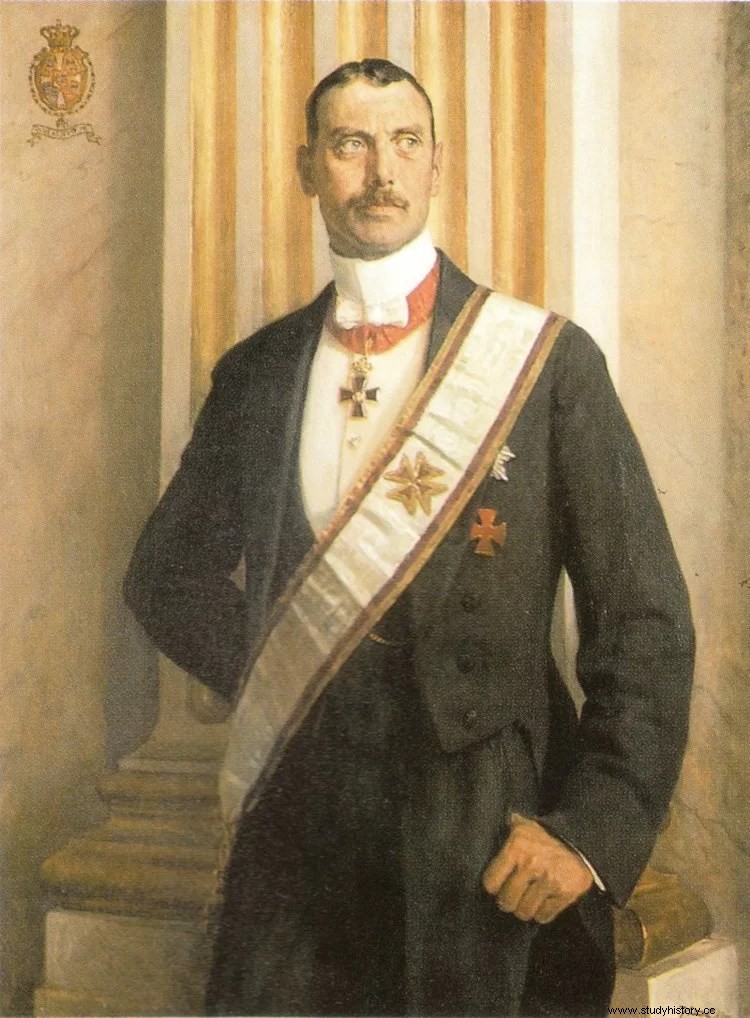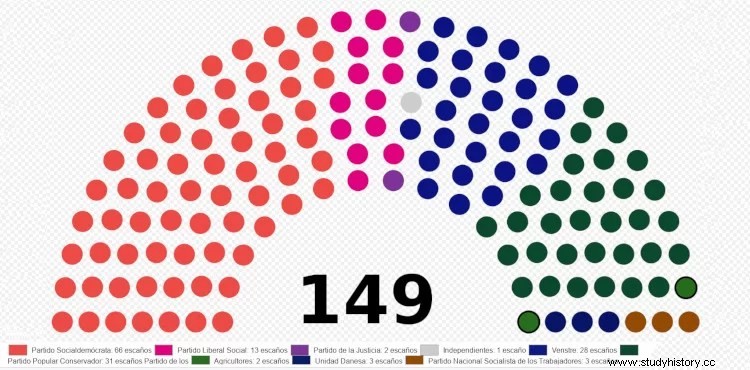On March 23, 1943, general elections were held in Denmark, the first to be held since the country had been invaded by Germany three years earlier, in the context of World War II.
The participation was massive and the Germans expected the victory or, at least, a good result of the Danish Nazi party, but it only got a meager 2.1% of the votes and from then on, it changed the more or less friendly tone that it had had the German presence.
The Wehrmacht had crossed the Danish border on April 9, in what became known as Operation Weserübung . It was a breach of neutrality announced by Prime Minister Thorvald Stauning, a Social Democrat who chose not to resist, which he could hardly do anyway because his army barely numbered thirty thousand. On the other hand, he knew that what Hitler was interested in was using the country as a passageway to Norway, the perfect base for the Luftwaffe planes. they could bomb Britain (and with the rich Swedish iron mines nearby) and a danger to Germany itself if the British decided to occupy it first.

The presence of German soldiers on Danish soil was not as uncomfortable as elsewhere. After all, the Danes were seen as racial brothers and so control was rather loose in the early years of the war, to the point that King Christian X was allowed to keep the throne and no claim was even made. the territories that the Treaty of Versailles had taken from Germany, except for the Aalborg airfields in Jutland, due to their strategic interest. Yes, press censorship and administrative control were imposed, which, however, was not very different from what existed in Germany itself.
Stauning died in May 1942 and was succeeded first by Vilhelm Buhl, and then by Erik Scavenius, both also from the Socialdemokratiet , since his natural heir, Hans Hedtoft, was vetoed by the German authorities for considering him too critical of them and showing excessive protectiveness towards the Jews.

By then, the various legal political parties (the communist party was banned in 1941, after pressure from the occupiers) agreed that, since independence had been lost as a lesser evil, they would at least try to minimize their ideological differences in order to make a common front. and prevent their disunity from redounding to the benefit of the invader and giving wings to the Danish Nazis, for which representatives of all entered the executive.
The DNSAP (Danmarks Nationalsocialistiske Arbejderparti ) had been founded in 1930, following the success of their German colleagues in the Reichstag elections. In fact, it was practically an exact replica, with a swastika, salute, adapted anthem and even an assault section like the SA.

On the other hand, his anti-Semitism was not so aggressive and he showed fidelity to the crown, as well as respect for the National Church (Evangelical Lutheran). Now, the big difference was that the Danish Nazis barely managed to attract a few hundred militants and failed in the 1932 elections, which is why their leader, Cay Lembcke, resigned.
The witness was taken by Frits Clausen, a forty-year-old Prussian doctor, ex-member of the DKF (Det Konservative Folkepar ti, Conservative Party) and veteran of the Kaiser's army in World War I, who distinguished himself defending the German minority in Jutland. Under his leadership, the Nazi party grew to 20,000 members, enabling it to win three seats in the Folketing (Danish parliament) in 1939, although the result was considered disappointing.

Of course, he was a defender of the invasion and took pains to highlight the benign treatment of the Germans, hence they pressured the king to force Clausen to admit to the government.
But the monarch refused and Hitler did not want to insist so as not to upset a Denmark whose submission suited him so well, so he preferred to wait for the next elections; he trusted that, then, the DNSAP would take the definitive leap and above all in a legal way.
In the meantime, he was content to force the country to enter the Anti-Comintern Pact in 1941, to establish trade relations clearly favorable to Germany, and to allow the police collaboration of the Gestapo.
But, above all, at the end of 1942 he imposed the figure of a delegate or commissioner with veto power over the government (the appointee was Cecil von Renthe-Fink, former ambassador in Copenhagen) when the executive refused to apply the anti-Semitic legislation .
As, likewise, this one did not want to authorize the incorporation of citizens to the SS, the Danish army was under direct authority of the Wehrmacht. And it is that the situation had taken a turn after the Teutonic defeats in Stalingrad and El Alamein, which fueled the birth of a resistance in Denmark and the consequent sabotage.

In order to calm things down, Berlin authorized something unusual in an occupied country:free elections (without communists, yes). They were convened for March 1943 and were twice, to the Folketing and the Landstinget (the upper house, which would be abolished in 1953), although in the second case they were set for April 6 and in the Faroe Islands for May.
Citizens interpreted the elections as a way to demonstrate against the occupation, hence the participation was a historical record of 89.5%. The results were once again a disappointment for the Nazis.
For the Folketing, the four major democratic parties shared 95% of the vote, with the Social Democrats winning 44.5% (66 seats), followed by the Conservatives with 21% (31 seats), the Conservative-Liberal Venstre with 18.7% (28 seats) and the liberal-social with 8.7% (13 seats). Next came Dansk Samling (Danish Unity, a mixture of socialism, liberalism and Christian nationalism) with 2.2% (3 seats). The DNSAP remained at 2.1%, also with 3 seats that did not improve those obtained nine years before; in the Faroe Islands it didn't even get representation.

As for the Landstinget, the turnout was equally massive (88.8%), with a Social Democratic victory (34 seats) followed by Venstre (18), Conservatives (14) and Socio-Liberals (8). The other parties were left without representatives and in the Faroe Islands there were no elections, since the only member was the same one elected in 1939. In short, the elections were a severe setback for Clausen and for Germany, where the press addicted to the regime published editorials disqualifying the immaturity of Danish citizens.
Something that is ironic if one takes into account that later there would be analysts who saw in that episode one more example of samarbejdspolitikken , that is, cooperation with Nazi designs by continuing political life as if Denmark were not occupied. In any case, that fiction did not last long; that same summer there were popular demonstrations due to the worsening economy and the German authorities dissolved the government and parliament, decreeing martial law, arresting Danish military commanders and replacing local officials with Germans.

That is to say, the panorama was completely changed and the occupation ceased to be friendly. The merchant fleet was seized and the deportation of Jews began, although many were able to escape to Sweden when warned in time. By 1944, the Gestapo and the Danish Nazis assumed control of public order.
By then Frits Clausen had just returned, who, disillusioned with his failure, had enlisted in the Wehrmacht to go to the Eastern Front as a surgeon. However, he did not want to take part in the project to form a branch of the SS and resigned his position, being replaced by a triumvirate.
At the end of the war he was confined in the Frøslev prison camp, the same one where the Danish communists and dissidents had been imprisoned, and which now served as a prison for Germans and collaborators. He died in 1947 while on trial; the same year he was appointed Prime Minister Hans Hedtoft, that leader of the Socialdemokratiet vetoed in 1941.
